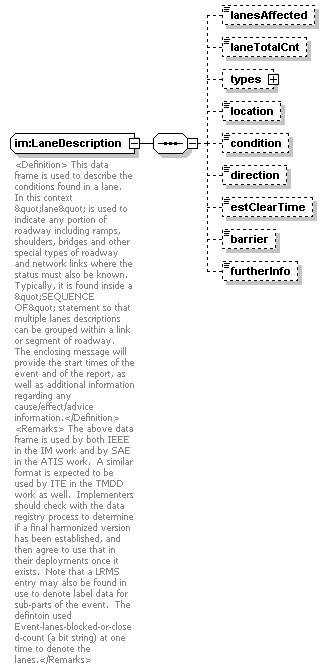
| elements | EventInformation/affectedLane IncidentInformation/affectedLanes LinkTrafficInformation/affectedLanes |
| documentation |
| <Definition> This data frame is used to describe the conditions found in a lane. In this context "lane" is used to indicate any portion of roadway including ramps, shoulders, bridges and other special types of roadway and network links where the status must also be known. Typically, it is found inside a "SEQUENCE OF" statement so that multiple lanes descriptions can be grouped within a link or segment of roadway. The enclosing message will provide the start times of the event and of the report, as well as additional information regarding any cause/effect/advice information.</Definition> <Remarks> The above data frame is used by both IEEE in the IM work and by SAE in the ATIS work. A similar format is expected to be used by ITE in the TMDD work as well. Implementers should check with the data registry process to determine if a final harmonized version has been established, and then agree to use that in their deployments once it exists. Note that a LRMS entry may also be found in use to denote label data for sub-parts of the event. The defintoin used Event-lanes-blocked-or-closed-count (a bit string) at one time to denote the lanes.</Remarks> |
<xs:annotation>
<xs:documentation>
<Definition> This data frame is used to describe the conditions found in a lane. In this context "lane" is used to indicate any portion of roadway including ramps, shoulders, bridges and other special types of roadway and network links where the status must also be known. Typically, it is found inside a "SEQUENCE OF" statement so that multiple lanes descriptions can be grouped within a link or segment of roadway. The enclosing message will provide the start times of the event and of the report, as well as additional information regarding any cause/effect/advice information.</Definition>
<Remarks> The above data frame is used by both IEEE in the IM work and by SAE in the ATIS work. A similar format is expected to be used by ITE in the TMDD work as well. Implementers should check with the data registry process to determine if a final harmonized version has been established, and then agree to use that in their deployments once it exists. Note that a LRMS entry may also be found in use to denote label data for sub-parts of the event. The defintoin used Event-lanes-blocked-or-closed-count (a bit string) at one time to denote the lanes.</Remarks>
</xs:documentation>
</xs:annotation>
<xs:sequence>
<xs:element name="lanesAffected" type="atis:LaneCount" minOccurs="0"/>
<!-- a count of the affected lanes -->
<xs:element name="laneTotalCnt" type="atis:LaneCount" minOccurs="0"/>
<!-- the number of nominal lanes for the link,
zero indicates the count is unknown -->
<xs:element name="types" minOccurs="0">
<xs:complexType>
<xs:sequence maxOccurs="8">
<xs:element name="type" type="itis:LaneRoadway"/>
<!-- the ITIS codes for various lane types such as: HOV, left, right, all, ramp, bridge, etc. -->
</xs:sequence>
</xs:complexType>
</xs:element>
<xs:element name="location" type="itis:GenericLocations" minOccurs="0"/>
<!-- the ITIS code for generic locations beside a lane
such as: opposing lanes, on ramps, etc ... -->
<xs:element name="condition" type="itis:Closures" minOccurs="0"/>
<!-- the ITIS codes for various conditions for the lane
such as: blocked, closed, closed ahead, clearing, etc -->
<xs:element name="direction" type="atis:Direction" minOccurs="0"/>
<!-- set to indicate if this description pertains to both directions
on the link or just to one -->
<xs:element name="estClearTime" type="atis:DateTimePair" minOccurs="0"/>
<!-- the point in time when the above conditions are estimated to be
removed and the flow over the lane/link returned to normal -->
<xs:element name="barrier" type="tmdd:Link-median-type" minOccurs="0"/>
<!-- the type of barrier found between the lanes -->
<xs:element name="furtherInfo" type="FreeText" minOccurs="0"/>
<!-- if information on why the lane (s) was closed, or how the lane (s)
was closed, or what will allow it to reopen is needed, place such
data in free text here. Limit use to only lane inforamtion, do not
use it for general event information.
When one of the above items does not apply (i.e. would be represented as zero)
then it should not be sent. -->
</xs:sequence>
</xs:complexType>
